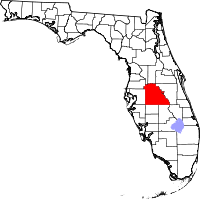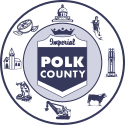Lakeland-Winter Haven, Florida Metropolitan Statistical Area
| Polk County, Florida | ||
|---|---|---|

Polk County courthouse in Bartow
|
||
|
||
 Location in the U.S. state of Florida |
||
 Florida's location in the U.S. |
||
| Founded | February 8, 1861 | |
| Named for | James K. Polk | |
| Seat | Bartow | |
| Largest city | Lakeland | |
| Area | ||
| • Total | 2,011 sq mi (5,208 km2) | |
| • Land | 1,798 sq mi (4,657 km2) | |
| • Water | 213 sq mi (552 km2), 10.6% | |
| Population (est.) | ||
| • (2016) | 666,149 | |
| • Density | 370/sq mi (143/km²) | |
| Congressional districts | 9th, 10th, 15th, 17th | |
| Time zone | Eastern: UTC-5/-4 | |
| Website | www |
|
Polk County is located in the State of Florida. The county population was 602,095, as of the 2010 census. Its county seat is Bartow, and its largest city is Lakeland.
Polk County comprises the Lakeland-Winter Haven Metropolitan Statistical Area. This MSA is the 87th most populous metropolitan statistical area and the 89th most populous primary statistical area of the United States as of July 1, 2012.
The center of population of Florida is located in Polk County, near the city of Lake Wales.
Polk County is home to one public university, one state college, and four private universities. One Fortune 500 company – Publix Super Markets — has headquarters in the county.
The first people to call Polk County home arrived close to 12,000 years ago during the last ice age as the first paleo-indians following big game southward arrived on the peninsula of Florida. By this time, the peninsula had gone through several expansions and contractions due to changing sea level; at times the peninsula was much wider than it is today, while at other times it was almost entirely submerged with only a few small islands exposed. These first paleo-indians, nomadic hunter/gatherers who did not establish any permanent settlements, eventually gave way to the "archaic people", the ancestors of the Indians who came in contact with the Spaniards when they arrived on the peninsula. These Indians thrived on the peninsula and it is estimated that there were over 250,000 in 1492 when Columbus set sail for the New World. As was common elsewhere, contact with Europeans had a devastating effect on the Indians. Smallpox, measles, and other diseases, to which the Indians had no immunity, caused widespread epidemic and death. Those who had not succumbed to diseases such as these were often either killed or enslaved as Spanish explorers and settlers arrived. Within a few hundred years, nearly the entire pre-columbian population of Polk County had been wiped out. The remnants of these Indians joined with refugee Creek Indians from Georgia and The Carolinas to form the Seminole Indian Tribe.
...
Wikipedia

